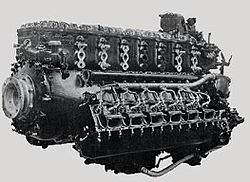Junkers Jumo 210
| Junkers Jumo 210 | |
|---|---|
 Junkers Jumo 210 |
|
| Type: | Twelve-cylinder - V engine |
| Design country: | |
| Manufacturer: | |
| Production time: |
1934-1938 |
| Number of pieces: |
approx. 6,500 |
The Junkers Jumo 210 was a liquid-cooled, twelve-cylinder engine - aircraft engine with a displacement of 19.7 liters and a take-off power of up to 730 hp. From 1934 to 1938 Junkers Motorenbau and Junkers Flugzeug- und Motorenwerke produced a total of around 6500 pieces of all versions.
The Jumo 210 G version, which was produced from 1937, was - even before the Daimler-Benz DB 601 - the first gasoline engine with direct fuel injection to be mass-produced . The successor was the Jumo 211 with 35 liters displacement and up to 1500 hp , which was produced from late summer 1937 .
history
At the beginning of the 1930s, the German engine manufacturers were asked by the Reich Ministry of Transport to develop an 800 HP aircraft engine, which was to be designed as a V-engine with "hanging" cylinders and which was suitable for military and civil purposes. The V-engine was installed rotated by 180 degrees so that the crankshaft was on top (hence also called " A-engine "). This type of engine installation also made it easier to access cylinder heads ( valve control ) and spark plugs for maintenance.
1931 then started in Dessau , the Junkers engine GmbH under the direction of Otto Mader with the development of the Jumo 210. The new engine turned over its predecessor, the V-12 engine L 88 with vertical engine (crankshaft below) a generational leap because it was first designed by Junkers taking into account the vibration behavior in the barrel. With the predecessor, attempts were made to minimize vibrations by using oversized components, but this led to a high weight with large moving masses . The weight reduction achieved through the optimized parts such as the crankshaft, connecting rods , pistons etc. allowed much higher speeds, so that the Jumo 210 only had about half the power to weight ratio of the L 88.
At the end of 1934, the first series engines of the type Jumo 210 A were delivered. The flight tests took place in a Junkers W 33 . Jumo 210 were used in the early versions of the Messerschmitt Bf 109 (A to D), the Messerschmitt Bf 110 (A / B) and the Ju 87 A. The Me-262 prototype V1 was tested with a Jumo 210 G installed in the bow, as the jet engines provided were not yet available or were still very unreliable.
The variants of the Jumo 210 comprised versions with different propeller ratios for use in different speed ranges and versions with a single or two-speed supercharger ( radial compressor ) driven by the crankshaft . By installing the injection system developed by August Lichte (1902–1978) from 1934 onwards, the Jumo 210 G was the world's first series-produced aircraft engine with direct fuel injection and automatic mixture control. It was installed in the Bf 109 C and Bf 110 B , among others .
The Junkers Jumo 211 with 35 l displacement - the geometrically enlarged ( "cranesbill engine " ) version of the Jumo 210 - was developed as a successor from 1935 onwards.
variants
- Jumo 210 A (1934)
- Carburettor engine, starting power about 610 HP (449 kW)
- Jumo 210 B / C (1935)
- Petrol engine, Start Power 600 hp (441 kW) at 2700 min -1 km, 640 hp maximum power in height 2.8
- Jumo 210 D / E (1936)
- Carburettor engine with two-speed charger , takeoff power 680 hp (500 kW) at 2700 min −1 , 690 hp maximum power at an altitude of 800 m
- Jumo 210 G (1937)
- such as 210 D, but with Junkers-direct fuel injection instead of the carburetor, starting power 730 hp (537 kW) at 2700 min -1
The differences between Jumo 210 B / C and D / E lie in a different reduction ratio of the propeller gear for fast (210 B / D) or slow (210 C / E) aircraft.
Technical specifications
Jumo 210 D
- Type: liquid-cooled twelve-cylinder V-engine
- Bore : 124 mm
- Stroke : 136 mm
- Displacement : 19.7 liters
- Compression ratio : 6.5: 1
- Setup weight: 440 kg
- Take-off power: 680 hp (500 kW) at a speed of 2700 min −1
See also
Individual evidence
- ↑ Kyrill von Gersdorff, Kurt Grasmann: Die Deutsche Luftfahrt. Volume 2 - Aircraft Engines and Jet Engines. Bernard & Graefe Verlag, Munich 1981, ISBN 3-7637-5272-2 , p. 77.
- ↑ Gersdorff, Grasmann: Die Deutsche Luftfahrt. Volume 2, Bernard & Graefe, p. 82.
literature
- Reinhard Müller: Junkers aircraft engines. Aviatic Verlag GmbH, 2006, ISBN 3-925505-79-2 .
Web links
- Hugo Junkers homepage
- Junkers injection system at: www.der-werftverein.de Online ( Memento from March 9, 2014 in the Internet Archive ) (pdf, 3.7 MB)